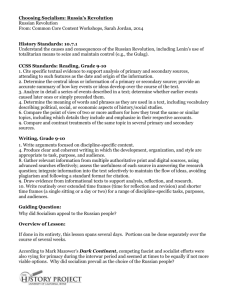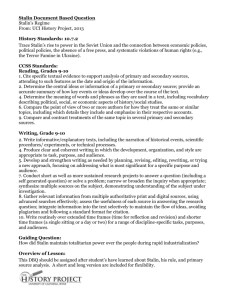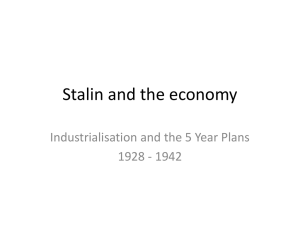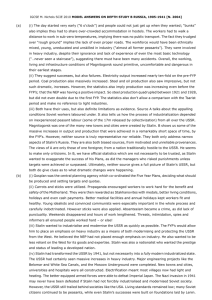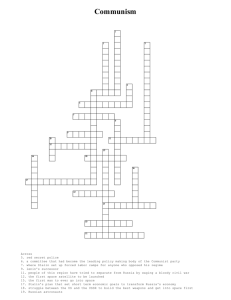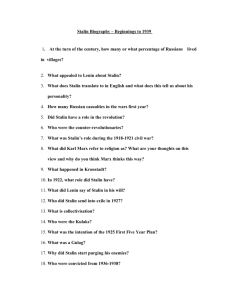Stalin DBQ
advertisement
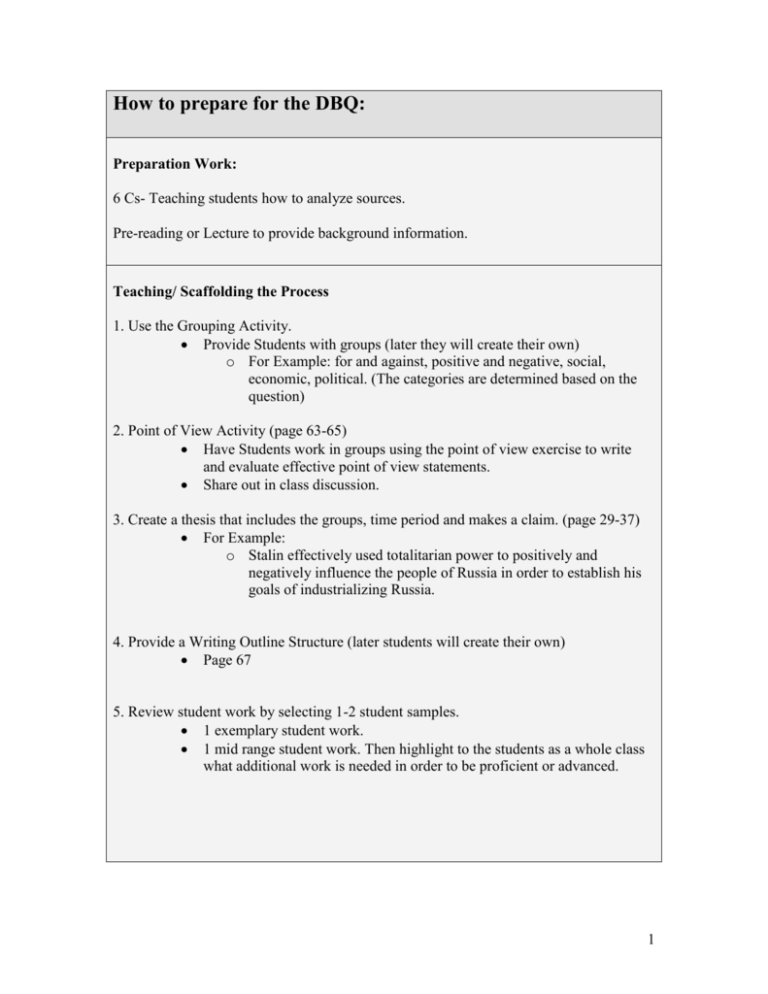
How to prepare for the DBQ: Preparation Work: 6 Cs- Teaching students how to analyze sources. Pre-reading or Lecture to provide background information. Teaching/ Scaffolding the Process 1. Use the Grouping Activity. Provide Students with groups (later they will create their own) o For Example: for and against, positive and negative, social, economic, political. (The categories are determined based on the question) 2. Point of View Activity (page 63-65) Have Students work in groups using the point of view exercise to write and evaluate effective point of view statements. Share out in class discussion. 3. Create a thesis that includes the groups, time period and makes a claim. (page 29-37) For Example: o Stalin effectively used totalitarian power to positively and negatively influence the people of Russia in order to establish his goals of industrializing Russia. 4. Provide a Writing Outline Structure (later students will create their own) Page 67 5. Review student work by selecting 1-2 student samples. 1 exemplary student work. 1 mid range student work. Then highlight to the students as a whole class what additional work is needed in order to be proficient or advanced. 1 Short Version Stalin: Document Based Question Directions: The following question is based on the accompanying Documents 1-5. (The documents have been edited for the purpose of this exercise.) The question is designed to test your ability to work with and understand historical documents. Write an essay that Has a relevant thesis and supports that thesis with evidence from the documents. Uses all the documents. Analyzes the documents by grouping them in as many appropriate ways as possible. Does not simply summarize the documents individually. Takes into account the sources of the documents and analyzes the author’s point of view. Superior essays identify and explain the need for at least one additional type of document. You may refer to relevant historical information not mentioned the documents. Question: Based on the following documents, analyze how Stalin maintained totalitarian power over the people during rapid industrialization? Historical Background: In 1917, Russia became the first Communist country led by Lenin and later by Joseph Stalin. Joseph Stalin led the Soviet Union on a state-sponsored program of rapid industrialization. However, in order to achieve his goals he caused widespread human suffering with his series of Five-Year Plans. Document 1: Source: I. V. Stalin, Problems of Leninism (Moscow: Foreign Language Publishers, 1934), pp. 391-93, 408-9, 411-12. ... Now we are able to carry on a determined offensive against the kulaks, to break their resistance, to eliminate them as a class and substitute for their output the output of the collective farms and state farms. There is another question which seems no less ridiculous: whether the kulaks should be permitted to join the collective farms. Of course not, for they are sworn enemies of the collective-farm movement .... 2 Document 2: This poster promotes mechanization of agriculture on large collective farms. Peasants were urged to work in brigades, as in industry, to increase productivity. The poster visualizes an ideal of disciplined workers in ordered fertile fields. The robust figures give no hint of the actual crop failures and famine in 1931-32 that resulted from forced collectivization. Source: Maria Voron: Shock-brigade Reaping for a Bolshevik Harvest (1934) Publisher: Peter Paret, Beth Irwin Lewis, Paul Paret: Persuasive Images: Posters of War and Revolution from the Hoover Institution Archives. Princeton: Princeton University Press. 1992. 3 Document 3: A parade, tanks, military airplanes and soldiers: Stalin may be smiling friendly, but war preparations are in full swing. Source: Sirocenqo, 1938 Long live the great Stalin! Document 4: One Day in the Life of Ivan Denisovich or Odin den’ Ivana Denisovicha "Apart from sleep, the only time a prisoner lives for himself is ten minutes in the morning at breakfast, five minutes over dinner, and five at supper." pg. 14 This book is written as a narrative that describes the experiences and feelings of prisoners who were located at a Russian Labor Camp (Gulag) probably in Siberian. Source: Solzhenitsyn, Alexander . One Day in the Life of Ivan Denisovich or Odin den’ Ivana Denisovicha. Russia: The Soviet journal Novy Mir , 1959-1962. 14. Print. 4 Long Version Stalin: Document Based Question Directions: The following question is based on the accompanying Documents 1-5. (The documents have been edited for the purpose of this exercise.) The question is designed to test your ability to work with and understand historical documents. Write an essay that Has a relevant thesis and supports that thesis with evidence from the documents. Uses all the documents. Analyzes the documents by grouping them in as many appropriate ways as possible. Does not simply summarize the documents individually. Takes into account the sources of the documents and analyzes the author’s point of view. Superior essays identify and explain the need for at least one additional type of document. You may refer to relevant historical information not mentioned the documents. Question: Based on the following documents, analyze how Stalin maintained control over the people during rapid industrialization? Historical Background: In 1917, Russia became the first Communist country led by Lenin and later by Joseph Stalin. Joseph Stalin led the Soviet Union on a state-sponsored program of rapid industrialization. However, in order to achieve his goals he caused widespread human suffering with his series of Five-Year Plans. 5 Document 1: Source: I. V. Stalin, Problems of Leninism (Moscow: Foreign Language Publishers, 1934), pp. 391-93, 408-9, 411-12. ... Now we are able to carry on a determined offensive against the kulaks, to break their resistance, to eliminate them as a class and substitute for their output the output of the collective farms and state farms. Now, the kulaks are being expropriated by the masses of poor and middle peasants themselves, by the masses who are putting solid collectivization into practice. Now, the expropriation of the kulaks in the regions of solid collectivization is no longer just an administrative measure. Now, the expropriation of the kulaks is an integral part of the formation and development of the collective farms. Consequently it is now ridiculous and foolish to discourse on the expropriation of the kulaks. You do not lament the loss of the hair of one who has been beheaded. There is another question which seems no less ridiculous: whether the kulaks should be permitted to join the collective farms. Of course not, for they are sworn enemies of the collective-farm movement .... Moscow: Sovetskii khudozhnik. 1984. 6 Document 2: This poster promotes mechanization of agriculture on large collective farms. Peasants were urged to work in brigades, as in industry, to increase productivity. The poster visualizes an ideal of disciplined workers in ordered fertile fields. The robust figures give no hint of the actual crop failures and famine in 1931-32 that resulted from forced collectivization. Source: Maria Voron: Shock-brigade Reaping for a Bolshevik Harvest (1934) Publisher: Peter Paret, Beth Irwin Lewis, Paul Paret: Persuasive Images: Posters of War and Revolution from the Hoover Institution Archives. Princeton: Princeton University Press. 1992. 7 Document 3: Stalin, On Deficiencies in Party Work and Measures for Liquidating Trotskyites and other Double-dealers. March 29, 1937 Comrades! From the reports and the discussions of them at the plenary session [of the Central Committee], it is obvious that we have here a matter involving three basic facts. First, the wrecking and diversionist-espionage work of the agents of foreign states, among whom the Trotskyites have played a rather active role, has touched to this or to that extent all or almost all of our organizations, both economic and administrative or party. Second, the agents of foreign states, including Trotskyites, have penetrated not only into our lower organizations but also into some of the responsible positions. Third, some of our leading comrades, both at the center and in outlying regions, have not only been unable to see the real face of these wreckers, diversionists, spies, and murderers but have proven to be careless, indifferent, and naive about it, and not infrequently they have cooperated in promoting the agents of foreign states into this or that responsible position. Source: Robert H. McNeal, ed., Lenin. Stalin. Khrushchev. Voices of Bolshevism (Englewood Cliffs: Prentice Hall, 1963), pp. 107-112. Document 4: Greetings to the best shock workers--heroes of socialist labor. This poster was mass printed for the bulletin boards of factories, which would place the portraits of their own local shock workers in the empty spaces. Source: Our Nobles (1935) 8 Document 5: Supreme Council of the USSR, Statute on the Rank of Hero of Socialist Labor. December 27, 1938 1. The rank of Hero of Socialist Labor represents the highest grade of distinction in the sphere of economic and cultural construction, and is awarded to persons who by their specially distinguished pioneer work in the sphere of industry, agriculture, transport, trade, scientific discovery and technical invention have rendered exceptional service to the State, promoted the progress of the national economy, culture, science and the growth of the power and glory of the USSR 2. The rank of Hero of Socialist Labor is awarded by the Presidium of the Supreme Council of the USSR 3. The Hero of Socialist Labor is awarded: (a) the highest award in the USSR - the Order of Lenin. (b) a special diploma of the Presidium of the Supreme Council of the USSR. 4. The Order of Lenin received simultaneously with the rank of Hero of Socialist Labor entitles the recipient to a cash bonus amounting to twice his wages. 5. The Hero of Socialist Labor is entitled to the rights and privileges stipulated in Articles 10-16 of the General Statute of Orders of the USSR (Code of Laws of the USSR, No. 24, Art. 220-b). 6. The Hero of Socialist Labor may be deprived of his rank only by order of the Presidium of the Supreme Council of the USSR President of the Presidium of the Supreme Council of the USSR. (Signed) M. Kalinin. Secretary of the Presidium of the Supreme Council of the USSR. (Signed) A. Gorkyn. Original Source: Izvestiia, 28 December 1938. 9 Citations: Bentley, Jerry, and Herb Ziegler. Traditions & Encounters: A Global Perspective on the Past. 3. Boston, MA: Mc Graw Hill, 2006. 990-1001. Print. Lastvon Geldern , James, and Lewish Siegelbaum. "1936: The Great Terror." SEVENTEEN MOMENTS IN SOVIET HISTORY. 2010. Seventeen Moments in Soviet History, Web. 1 Jan 2010. <http://soviethistory.org/index.php>. "Nivinskii, Women, adhere to the cooperation, 1917." International Institute of Social History. Web. 7 Jan 2010. <http://www.iisg.nl/exhibitions/chairman/sovintro.php>. "Sirocenqo, 1938." International Institute of Social History. Web. 7 Jan 2010. <http://www.iisg.nl/exhibitions/chairman/sov33.php>. Solzhenitsyn, Alexander . One Day in the Life of Ivan Denisovich or Odin den’ Ivana Denisovicha. Russia: The Soviet journal Novy Mir , 1959-1962. 14. Print. . 10
